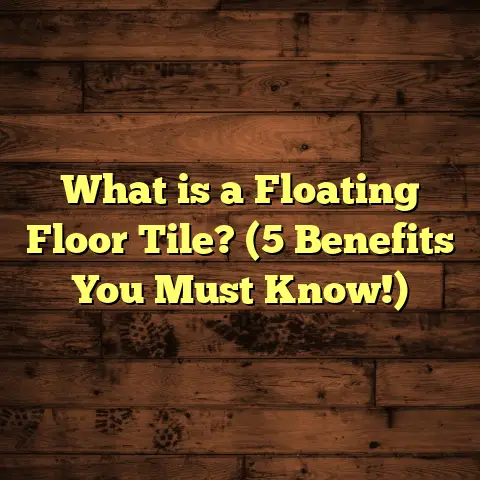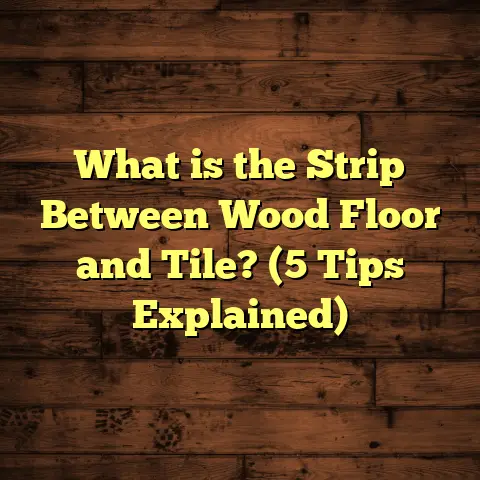What is Code for Under Floor Insulation? (5 Essential Guidelines)
When I first got into flooring and insulation work, I didn’t think much about the “codes” behind under floor insulation. I thought insulation was just about putting some material under the floor and calling it a day. But the more projects I handled, the more I realized how important it is to understand the rules and regulations that govern this part of construction. Without the right knowledge, you risk wasting money, hurting your home’s comfort, and even causing damage.
If you’re thinking about insulating beneath your floors or just curious about what standards exist, I want to share what I’ve learned over the years. My goal is to help you understand what the codes mean and how to apply them practically so your project goes smoothly. Let’s explore this together.
What Is Code for Under Floor Insulation?
At its core, a “code” in construction is a set of standards created by government agencies or regulatory bodies. These codes are there to make sure building practices meet minimum safety, health, and energy efficiency requirements. When we talk about code for under floor insulation, we’re referring to specific regulations that dictate how insulation must be installed beneath floors—whether it’s in crawl spaces, slab-on-grade foundations, or raised wooden floors.
These codes cover everything from:
- The types of insulation materials allowed.
- Minimum thermal resistance values (R-values).
- Moisture control measures like vapor barriers.
- Ventilation requirements.
- Installation techniques to prevent gaps or compression.
- Fire safety considerations.
In the U.S., for example, codes from the International Residential Code (IRC) and International Energy Conservation Code (IECC) are often adopted by states or municipalities. Similarly, Canada uses the National Building Code of Canada (NBCC) with regional variations. Australia has its own Building Code of Australia (BCA) which includes under floor insulation requirements.
Why Are These Codes Necessary?
If you’ve ever walked into a chilly room during winter or noticed cold drafts near the floor, you’ve felt the impact of poor under floor insulation. The codes help prevent that by making sure insulation is effective and installed properly. But it’s not just about warmth—there are other reasons why these rules matter:
- Energy savings: Proper insulation reduces heating and cooling costs by minimizing heat loss through floors.
- Moisture control: Correct installation prevents moisture buildup under floors that can cause mold, rot, and structural damage.
- Indoor air quality: By controlling moisture and air leaks, insulation helps keep indoor air healthy.
- Durability: Following installation guidelines extends the life of flooring and underlying structural components.
- Safety: Some materials have fire resistance ratings or require specific treatments to meet safety standards.
I once worked on a project where ignoring vapor barrier requirements led to severe mold growth under the floor joists within a year. The homeowners ended up with thousands in repair costs—not to mention health risks. That experience really drove home how important these codes are.
5 Essential Guidelines for Under Floor Insulation Codes
Let me break down five key guidelines you need to understand when planning or inspecting under floor insulation. These points reflect requirements found in most codes combined with practical lessons from my work.
1. Choose the Right Insulation Material and R-Value
One of the first things I look at is what insulation material to use and what R-value is required by code in that location.
What is R-value?
To put it simply, R-value measures how well an insulation material resists heat flow. The higher the R-value, the better it insulates.
Codes usually specify minimum R-values based on climate zones because colder climates need thicker or more effective insulation.
| Climate Zone | Typical Minimum R-Value for Under Floors |
|---|---|
| Very Cold | R-30 to R-40 |
| Cold | R-19 to R-30 |
| Moderate | R-13 to R-19 |
| Warm | R-13 or less |
Common Materials Used:
- Fiberglass Batts:
Pros: Affordable, widely available, easy DIY installation.
Cons: Can absorb moisture if not protected; performance drops if compressed or wet. - Rigid Foam Boards (XPS, EPS):
Pros: High moisture resistance, good thermal performance for thickness.
Cons: Higher upfront cost; requires cutting and fitting carefully. - Spray Foam (Closed-cell):
Pros: Acts as insulation and air sealant; excellent moisture resistance; high R-value per inch.
Cons: Expensive; professional installation required. - Mineral Wool:
Pros: Fire resistant; good soundproofing; water resistant but not waterproof.
Cons: Costlier than fiberglass; heavier.
When I worked on a project in Minnesota where temperatures dip below zero regularly, we used spray foam for its superior R-value and moisture resistance. It helped keep floors warm even during bitter cold snaps. In contrast, for a mild California home, fiberglass batts met code requirements and kept costs down.
Data Insight: Energy Savings Related to R-values
According to studies from the U.S. Department of Energy:
- Upgrading floor insulation from R-10 to R-30 can reduce heating energy consumption by roughly 10%-15%.
- Proper insulation installation can save homeowners between $200-$400 annually on energy bills depending on climate.
Choosing the right material isn’t just about meeting code but optimizing long-term savings and comfort.
2. Vapor Barriers Are Critical—and Code-Mandated
Have you ever noticed a musty smell in your basement or crawl space? That’s often moisture creeping in from the ground. Vapor barriers prevent this by blocking moisture from rising into your floor cavity—where it can condense on cold surfaces causing mold and rot.
Most building codes require installing a vapor barrier beneath or above your under floor insulation when:
- The floor is over an unconditioned crawl space.
- The climate is humid or cold.
- The soil has high moisture content.
Common Vapor Barrier Materials:
Polyethylene plastic sheets of 6 mil thickness or greater are standard. Some high-performance barriers include foil-faced membranes with radiant heat reflective properties.
Installation Requirements per Code:
- Seams must overlap by at least 6 inches.
- Edges should be sealed with tape or adhesive.
- Barrier extends up foundation walls several inches.
- Penetrations like pipes must be sealed carefully with appropriate collars or sealants.
A memorable project involved removing old insulation with no vapor barrier in a coastal home prone to humidity. After installing a properly sealed polyethylene barrier beneath new spray foam insulation, moisture levels dropped dramatically—measured with hygrometers—resulting in drier air and healthier indoor conditions.
Data Point: Moisture Control
Research from the Building Science Corporation shows crawl spaces with vapor barriers have:
- Up to 70% less relative humidity compared to unsealed areas.
- Reduced risk of wood rot by over 80%.
Without vapor barriers, moisture can lead to structural damage costing thousands in repairs over time.
3. Ventilation Must Meet Code Specifications
You might wonder—if vapor barriers block moisture, why do we still need ventilation? Good question! Ventilation works by circulating air under the floor or in crawl spaces to carry away any residual moisture that does get in.
Most codes specify a minimum amount of vent area per square foot of crawl space:
- Typically around 1 square foot of vent per 150 square feet of crawl space.
- Vents should be placed on opposite walls for cross ventilation.
- Vents must be clear of obstructions like plants or debris.
I recall a project where vents were blocked by soil buildup after landscaping. This lack of airflow caused humidity spikes and musty odors inside the home during summer months. Clearing and maintaining vents restored proper airflow and eliminated the problem quickly.
When Is Ventilation Not Required?
Some modern codes allow for sealed (conditioned) crawl spaces without vents if they are properly insulated and have controlled mechanical ventilation systems. But this requires careful design and usually professional input to avoid moisture problems.
4. Proper Installation Techniques Are Part of Code Compliance
Even if you pick the right materials and follow all prep steps, poor installation can wreck all your efforts. Codes often include detailed instructions on how insulation should fit and be secured under floors:
- Fit should be snug between joists with no gaps or voids.
- Insulation must not be compressed as this reduces its R-value.
- Avoid blocking ventilation paths or ducts.
- Use supports such as wiring or mesh netting fixed securely beneath joists to hold insulation in place.
During one job, I found fiberglass batts loosely stuffed between joists with obvious gaps around plumbing pipes—this caused drafts and cold spots on the floor above. Reinstalling with proper supports and careful cutting improved comfort significantly.
Data Insight: Impact of Installation Quality on Performance
Laboratory tests show:
- Gaps as small as 1 inch around insulation can reduce overall floor R-value by up to 15%.
- Compression can reduce fiber batt effectiveness by over 25%.
Good installation isn’t just about code—it’s about making your materials work as intended.
5. Meet Local Energy Efficiency Requirements
Energy codes tie into building codes closely. They require minimum thermal performance levels for new construction and sometimes renovations.
Depending on where you live:
- You might need certification showing compliance with IECC or similar energy standards.
- Some areas require documentation of installed insulation type, thickness, and location.
- Certain programs offer incentives if you exceed minimum code requirements (think rebates for high-performance materials).
In my practice, I always check local energy standards before recommending solutions so clients don’t face surprises during inspections. This also helps identify opportunities for long-term savings.
Real-Life Examples & Case Studies
Let me share some detailed examples from my work illustrating these guidelines in real projects:
Case Study 1: New Build in Northern Climate
Location: Upstate New York
Floor area: 1,500 sq ft
Insulation: Closed-cell spray foam at R-35 + polyethylene vapor barrier + vented crawl space
Results:
Heating bills dropped by 22% compared to similar homes nearby without spray foam. Moisture meters showed relative humidity under crawl space dropped from 75% pre-insulation to 50%. The homeowner noted warmer floors even during sub-zero weather.
Costs:
Material + labor = approx $5 per sq ft for spray foam + $0.50 per sq ft for vapor barrier + ventilation work = $8,250 total.
Case Study 2: Renovation in Humid Coastal Area
Location: Florida
Floor area: 1,200 sq ft
Insulation: Fiberglass batts R-19 + properly sealed vapor barrier + new vents installed according to code
Results:
Indoor air quality improved; mold growth stopped entirely after vapor barrier added. Energy bills showed a modest drop but comfort level increased significantly due to reduced humidity and draftiness.
Costs:
Material + labor = approx $2 per sq ft; total ~$2,400 including ventilation improvements.
How I Use FloorTally for Planning & Budgeting
Estimating costs accurately can be overwhelming with all these factors—material types, labor rates, waste factors, regional price differences. Over time I started using FloorTally for quick calculations tailored to my local area.
It helps me:
- Input project dimensions and select materials easily.
- See detailed breakdowns including waste percentages.
- Compare costs between different materials like fiberglass vs spray foam.
- Factor in labor rates specific to my region.
This saves me hours of manual calculations or dealing with multiple quotes. Plus when clients ask for estimates upfront, I deliver numbers that are realistic and backed by current market data—not just rough guesses.
Common Myths About Under Floor Insulation Codes
I’ve heard plenty of myths over time that can confuse homeowners:
Myth #1: “Any insulation is fine as long as it covers the area.”
Reality: Material type and R-value matter greatly; cheap options can fail quickly without proper vapor barriers or installation.
Myth #2: “Vapor barriers trap moisture inside.”
Reality: When installed correctly beneath floors with proper ventilation around, vapor barriers prevent outside moisture from entering the crawl space rather than trapping indoor moisture.
Myth #3: “You don’t need vents if you have a vapor barrier.”
Reality: Most codes require both ventilation and vapor barriers unless you have a fully sealed conditioned crawl space designed by experts.
Myth #4: “Thicker insulation automatically means better performance.”
Reality: Compression or gaps reduce effectiveness; quality installation matters as much as thickness.
Personal Tips from My Toolbox
Over years on countless jobsites here’s what I’ve learned works best:
- Always check with local building department before buying materials—codes change periodically.
- If unsure about vent requirements or sealing techniques, consult a professional building inspector or engineer.
- Use a hygrometer during and after installation to monitor moisture levels—you’ll catch problems early.
- Keep detailed notes about materials used and installation methods for future reference or resale inspections.
- Don’t cut corners on vapor barriers—even a small tear can lead to big problems later.
What Happens If You Ignore These Codes?
I want to be honest here because some people try skipping these steps to save money short term—but it usually backfires badly:
- Moisture buildup causes mold which hurts health and damages wood framing.
- Heat loss through floors ramps up energy bills significantly.
- Structural rot can weaken floors leading to costly repairs or even safety hazards.
- Failed inspections delay projects or lead to fines.
A friend of mine had to rip up newly laid flooring after discovering missing vapor barriers caused wood joists to rot within two years—costing him over $12,000 extra.
Final Thoughts
Understanding what code means for under floor insulation isn’t rocket science but it does demand attention to detail. Follow these five essential guidelines—choose proper materials with right R-values, install vapor barriers correctly, ensure ventilation meets specs, install snugly without gaps or compression, and align with local energy codes—and you’ll save money over time while creating a healthier home environment.
If you’re tackling this type of project yourself or working with contractors, knowing these basics will help you ask smarter questions and avoid surprises down the road.
Got questions about your own flooring project? Want me to help figure out what’s required in your area? Just ask—I’m happy to share my experience and help out however I can!





